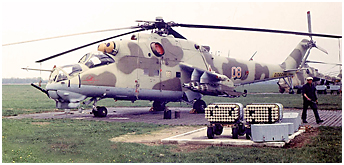 To recapitulate the chronology of the different Army Aviation units of the former Soviet Union regarding redistribution of
hardware, changes in unit strength and following relocations during the withdrawal to Mother Russia is a difficult and time
consuming job. Often subject of contempt and therefore largely ignored the regiments and independent helicopter squadrons of
the Armeiskaya Aviatsiya were subject, as far as they allowed it, to less media coverage than their counterpart combat
aircraft units of the 16th Air Army.
The discretion of the Russian military authorities, or better said, little desire to communicate at all (and we are not taking
here about the language barrier) has caused many blank spots up until today regarding the organization structure, the movements
and specific tasks of these units.
To recapitulate the chronology of the different Army Aviation units of the former Soviet Union regarding redistribution of
hardware, changes in unit strength and following relocations during the withdrawal to Mother Russia is a difficult and time
consuming job. Often subject of contempt and therefore largely ignored the regiments and independent helicopter squadrons of
the Armeiskaya Aviatsiya were subject, as far as they allowed it, to less media coverage than their counterpart combat
aircraft units of the 16th Air Army.
The discretion of the Russian military authorities, or better said, little desire to communicate at all (and we are not taking
here about the language barrier) has caused many blank spots up until today regarding the organization structure, the movements
and specific tasks of these units.
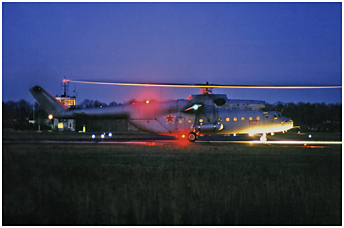 Largely associated with the units of the 16th Air Army, of which they had been part for a long period and with whom they shared nine airbases, the
regiments and squadrons of the Armeiskaya Aviatsiya were submitted in 1990 to the same flight restrictions as their
colleagues of the VVS. And as they continued to roam through the reunited German skies with their machines, most of the time
they were bond almost exclusively to local flights. As a single flight or in formation with more helicopters, the “Hind”,
“Hip” and “Hook” helicopters were only allowed to fly their training missions one to two days per week and often limited to
flying in circles.
The pinnacle was reached during night flying sessions. On these occasions the helicopters would mainly fly
in and around the base perimeters for hours. They would fly like insects around a lamp, as if being attached to the lines of
a carrousel, going up and down to practice their take offs and landings one by one.
Largely associated with the units of the 16th Air Army, of which they had been part for a long period and with whom they shared nine airbases, the
regiments and squadrons of the Armeiskaya Aviatsiya were submitted in 1990 to the same flight restrictions as their
colleagues of the VVS. And as they continued to roam through the reunited German skies with their machines, most of the time
they were bond almost exclusively to local flights. As a single flight or in formation with more helicopters, the “Hind”,
“Hip” and “Hook” helicopters were only allowed to fly their training missions one to two days per week and often limited to
flying in circles.
The pinnacle was reached during night flying sessions. On these occasions the helicopters would mainly fly
in and around the base perimeters for hours. They would fly like insects around a lamp, as if being attached to the lines of
a carrousel, going up and down to practice their take offs and landings one by one.
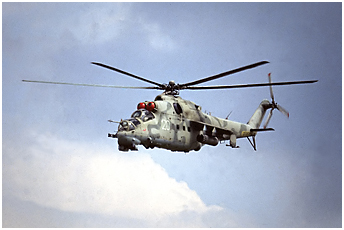
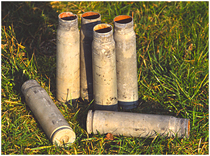 Quelques douilles de 30mm provenant des canons de Mi-24P, ramassées dans le fossé longeant la route 103
près du champ de tir de Retzow! © H.Mambour.
Quelques douilles de 30mm provenant des canons de Mi-24P, ramassées dans le fossé longeant la route 103
près du champ de tir de Retzow! © H.Mambour.
30mm empty shell casings from Mi-24P canons,
found in a ditch along the road 103 next to the Retzow firing range! © H.Mambour.
These were indeed reduced training missions, however, the helicopters were often seen flying with armament. It was not uncommon
for motorists driving along the Retzow firing range near the village of Parchim, to find 30mm or 12.7 shell casings
along the road, as the "Hind" jockeys pulled the triggers of their cannons too early.
The Russian helicopters take off procedure was atypical but full of common sense. After taxiing to a take-off strip or
runway, the pilot took off vertically and kept his helicopter in stationary flight at a few meters height.
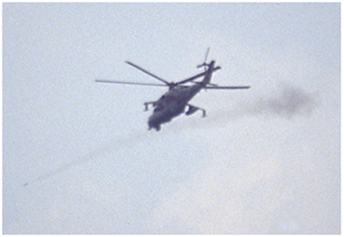 Tirs de roquettes S-5 de 57 mm par un Mi-24 au champ de tir de Retzow. © G.Botquin.
Tirs de roquettes S-5 de 57 mm par un Mi-24 au champ de tir de Retzow. © G.Botquin.
Mi-24 firing 57 mm S-5 rockets at the Retzow firing range. © G.Botquin.
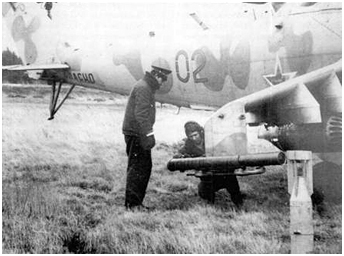 Installation d'un missile antichar Chtourm sur un Mi-24V du 336.OBVP de Nohra. A l'avant-plan, une bombe
FAB-50 attend son tour d'être accrochée sous le pylône externe à côté d'un conteneur lance-roquettes UB-32A. © DR.
Installation d'un missile antichar Chtourm sur un Mi-24V du 336.OBVP de Nohra. A l'avant-plan, une bombe
FAB-50 attend son tour d'être accrochée sous le pylône externe à côté d'un conteneur lance-roquettes UB-32A. © DR.
A Shturm ATGM is being prepared on a Mi-24V of the 336.OBVP from Nohra. A FAB-50 bomb is waiting
to be attached under the outboard pylon next to a UB-32A rocket pod. © DR.
This short stationary flight was intended to ensure that the rotor "caught" well out of ground effect and thus take off safely.
Once satisfied, the pilot landed before carrying a rolling takeoff in forward translation. The tail would lift once the
speed was sufficient and the helicopter took off with its nose pointed downward in order to quickly gain speed. In "departure from Germany" configuration
on a hot summer day, a Mi-8T with full tanks, including an additional fuel tank in the cargo hold and the latter filled with luggage, took off at around 120 km/h.
Whether it was windy, raining or snowing, these helicopters were almost always scattered in the open air. When they were not
used, their only protection was laced tarpaulins. This rustic treatment, however, did not seem to affect
their proper functioning, additional proof, if necessary, of the robustness of these helicopters.
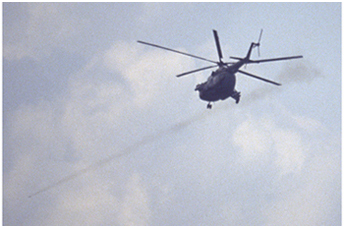 Un Mi-8MT au champ de tir de Retzow tire une roquette S-5. © G.Botquin.
Un Mi-8MT au champ de tir de Retzow tire une roquette S-5. © G.Botquin.A Mi-8MT firing a S-5 rocket at the Retzow range. © G.Botquin. |
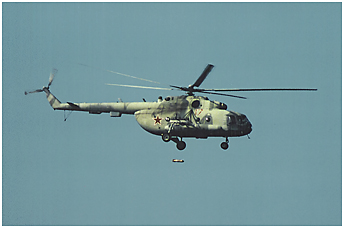
|
Ivan, go home!
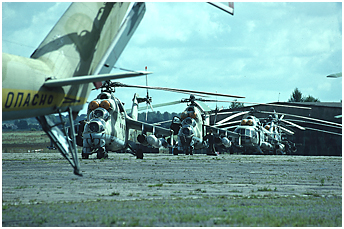 Of the once powerful Armeyskaya Aviatsiya in the former DDR, only a number of deserted and reconverted bases
remain today. The first units to leave in 1991 were the 225.OBVP at Allstedt, the 485.OVP BU at Brandis, the 486.OVP BU at Altes
Lager, the 487.OVP BU at Gross Dölln (of which the HQ was at Prenzlau), the 296.OVE BU at Mahlwinkel and the 9.OVE BU at Neuruppin.
However, the first retreats basically meant regrouping and relocating units to new bases in Germany. The helicopters of the 9.OVE BU from
Neuruppin went to Oranienburg, allowing the definitive closure of their former home base. The 487.OVP BU at Gross Dölln
relocated to Werneuchen, which became possible with the departure of the last MiG-25 “Foxbat” to Welzow. On the other hand,
the 225.OBVP at Allstedt and the 486.OVP BU at Altes Lager left Germany for good. The 225.OBVP left on 25 May 1991 for
its new destination at Protasovo in the Moscow military district.
The 486.OVP BU left for Ayagoz (Kaz.) on 17, 19 and 22 July and Usharal (Kaz.) on 1 August.
The helicopters were integrated into the newly established Kazakhstan Armed Forces after the breaking up of the USSR.
However the year 1991 turned out to be a starter and the rest was yet to come.
Of the once powerful Armeyskaya Aviatsiya in the former DDR, only a number of deserted and reconverted bases
remain today. The first units to leave in 1991 were the 225.OBVP at Allstedt, the 485.OVP BU at Brandis, the 486.OVP BU at Altes
Lager, the 487.OVP BU at Gross Dölln (of which the HQ was at Prenzlau), the 296.OVE BU at Mahlwinkel and the 9.OVE BU at Neuruppin.
However, the first retreats basically meant regrouping and relocating units to new bases in Germany. The helicopters of the 9.OVE BU from
Neuruppin went to Oranienburg, allowing the definitive closure of their former home base. The 487.OVP BU at Gross Dölln
relocated to Werneuchen, which became possible with the departure of the last MiG-25 “Foxbat” to Welzow. On the other hand,
the 225.OBVP at Allstedt and the 486.OVP BU at Altes Lager left Germany for good. The 225.OBVP left on 25 May 1991 for
its new destination at Protasovo in the Moscow military district.
The 486.OVP BU left for Ayagoz (Kaz.) on 17, 19 and 22 July and Usharal (Kaz.) on 1 August.
The helicopters were integrated into the newly established Kazakhstan Armed Forces after the breaking up of the USSR.
However the year 1991 turned out to be a starter and the rest was yet to come.
 1992 saw a lot of departures, no less than 7 regiments and three separate squadrons left from a total of 9 bases. It was
the 485.OVP BU at Brandis - where different specialized helicopters, including several Mi-9, had been redeployed from other units -
which started the exodus. On the morning of 22 April 1992 the first helicopters, equipped with additional fuel tanks, departed their home base
for a 15 hours long journey with nine stops to Alakurtti, a base situated in Russian Karelia, near Murmansk in the Leningrad military
district (St Petersburg). The regiment was reduced in May 1998 and it was renamed the 85.OVE. The unit is now a composite helicopter
squadron integrated into the 6960th Air Base at Alakurtti.
On the 7th July the secretive machines of the 292.OVE REB at Cochstedt left for Malino in the Moscow region, where the regiment was disbanded.
The 440.OVP BU at Stendal left its base between the 13th and the 16th July for Viazma, 200 kilometers southwest of Moscow in the
direction of Smolensk, where the personnel had the privilege of receiving newly built houses and flats paid for by the German government.
The regiment took part in several local conflicts including Chechnia, where some of its personnel distinguished themselves in the action.
Some peace-keeping missions were also flown in Angola, Sudan and Sierra Leone during the nineties. In 1999, the helicopters of the unit were
airfreighted by An-22 to Slatina in Kosovo for a deployment of several months for another peace-keeping mission with the KFOR. The 440.OVP BU was absorbed by the new
6996th Air Base in 2009. The latter is composed of one helicopter attack squadron and one helicopter transport squadron based at Viazma.
1992 saw a lot of departures, no less than 7 regiments and three separate squadrons left from a total of 9 bases. It was
the 485.OVP BU at Brandis - where different specialized helicopters, including several Mi-9, had been redeployed from other units -
which started the exodus. On the morning of 22 April 1992 the first helicopters, equipped with additional fuel tanks, departed their home base
for a 15 hours long journey with nine stops to Alakurtti, a base situated in Russian Karelia, near Murmansk in the Leningrad military
district (St Petersburg). The regiment was reduced in May 1998 and it was renamed the 85.OVE. The unit is now a composite helicopter
squadron integrated into the 6960th Air Base at Alakurtti.
On the 7th July the secretive machines of the 292.OVE REB at Cochstedt left for Malino in the Moscow region, where the regiment was disbanded.
The 440.OVP BU at Stendal left its base between the 13th and the 16th July for Viazma, 200 kilometers southwest of Moscow in the
direction of Smolensk, where the personnel had the privilege of receiving newly built houses and flats paid for by the German government.
The regiment took part in several local conflicts including Chechnia, where some of its personnel distinguished themselves in the action.
Some peace-keeping missions were also flown in Angola, Sudan and Sierra Leone during the nineties. In 1999, the helicopters of the unit were
airfreighted by An-22 to Slatina in Kosovo for a deployment of several months for another peace-keeping mission with the KFOR. The 440.OVP BU was absorbed by the new
6996th Air Base in 2009. The latter is composed of one helicopter attack squadron and one helicopter transport squadron based at Viazma.
 The second Stendal based regiment, the 178.OBVP, of which some Mi-24P and Mi-8 were redistributed to the 337.OBVP at Mahlwinkel,
left for Russia on 16 July 1992. A first group composed of approximately 30 Mi-24 “Hind” and some Mi-8 made a stop at Nohra
before leaving for Kaliningrad. The helicopters finally reached their final destination at Kursk-Richkovo on 22 July after seven stops.
On the same day the rest of the regiment arrived after leaving Stendal on 18 July. During the long voyage a Mi-24 declared an
emergency over Poland after the shut down of one engine in flight. The engine was replaced the next day and the helicopter
continued its journey.
Originally the 178.OBVP had to be relocated to Adji-Kabul in Azerbaijan, an Islamic republic, which after the breaking up of the
USSR would conflict with the neighbouring country Armenia about the control over the region of High-Karabakh.
It was General Burlakov himself who telephoned the regiment on a beautiful day in October 1991 to deliver the good news; the
regiment was going to Kursk instead! All liquor stores in a circle of 10 kilometers around Stendal were bought empty that day to
celebrate the good news and the flying activities of the day were cancelled!
In the same period the detachments of the 439.OVP BU and 172.OVP based at Lärz rejoined their mother base at Parchim. On 12
August 1992 the 336.OBVP at Nohra flew to Oreshkovo in the Moscow Military District. The regiment took part in several local conflicts,
including Chechnia. It was redesignated the 45.OVP BU on 1st October 1997 at Kaluga. That unit is now the 6965th Air Base and is
composed of one attack and one transport helicopter squadron based at Kaluga.
In June the 6.OVE BU would
lose its flying command posts and electronic warfare Mi-6VKP/Mi-22 "Hook B/C" and Mi-8PPA "Hip-K". The last helicopters would leave
Dresden Hellerau on 20 August for Parchim, from where they joined the two local regiments on their departure two months later.
The 6.OVE BU would have been redeployed to Viazma with its electronic warfare helicopters on 20 August 1992,
and the unit was finally disbanded. Some of its helicopters were probably integrated into
the 440.OVP BU, itself repatriated from Stendal.
The second Stendal based regiment, the 178.OBVP, of which some Mi-24P and Mi-8 were redistributed to the 337.OBVP at Mahlwinkel,
left for Russia on 16 July 1992. A first group composed of approximately 30 Mi-24 “Hind” and some Mi-8 made a stop at Nohra
before leaving for Kaliningrad. The helicopters finally reached their final destination at Kursk-Richkovo on 22 July after seven stops.
On the same day the rest of the regiment arrived after leaving Stendal on 18 July. During the long voyage a Mi-24 declared an
emergency over Poland after the shut down of one engine in flight. The engine was replaced the next day and the helicopter
continued its journey.
Originally the 178.OBVP had to be relocated to Adji-Kabul in Azerbaijan, an Islamic republic, which after the breaking up of the
USSR would conflict with the neighbouring country Armenia about the control over the region of High-Karabakh.
It was General Burlakov himself who telephoned the regiment on a beautiful day in October 1991 to deliver the good news; the
regiment was going to Kursk instead! All liquor stores in a circle of 10 kilometers around Stendal were bought empty that day to
celebrate the good news and the flying activities of the day were cancelled!
In the same period the detachments of the 439.OVP BU and 172.OVP based at Lärz rejoined their mother base at Parchim. On 12
August 1992 the 336.OBVP at Nohra flew to Oreshkovo in the Moscow Military District. The regiment took part in several local conflicts,
including Chechnia. It was redesignated the 45.OVP BU on 1st October 1997 at Kaluga. That unit is now the 6965th Air Base and is
composed of one attack and one transport helicopter squadron based at Kaluga.
In June the 6.OVE BU would
lose its flying command posts and electronic warfare Mi-6VKP/Mi-22 "Hook B/C" and Mi-8PPA "Hip-K". The last helicopters would leave
Dresden Hellerau on 20 August for Parchim, from where they joined the two local regiments on their departure two months later.
The 6.OVE BU would have been redeployed to Viazma with its electronic warfare helicopters on 20 August 1992,
and the unit was finally disbanded. Some of its helicopters were probably integrated into
the 440.OVP BU, itself repatriated from Stendal.
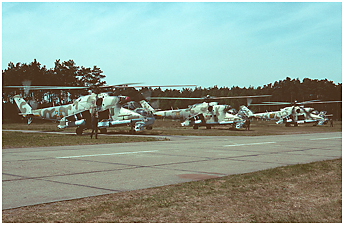 In the last week of October and first week of November a large number of helicopters of the 172.OBVP and 439.OVP BU from
Parchim left for Russia. Both regiments flew towards Tchernyakhovsk near Kaliningrad. The 172.OBVP continued its journey to its
destination Kazimovo in the Leningrad military district, whereas the 439.OVP BU flew to Kostroma in the Moscow military district.
However, before their departure from Germany, a number of helicopters of both regiments were redistributed to the bases
of Mahlwinkel, Oranienburg and Werneuchen and swapped for older machines which needed a major overhaul.
At about the same time, the 298.OVE BU at Hassleben left their quarters for Mother Russia; its Mi-2 did not left Germany at the
same time, as they firstly joined the ones at the 41.OVE BU at Werneuchen.
1992 also saw the definitive disappearance of all special versions - flying command posts and electronic warfare - of the Mi-8/9 from
the regiments which were planned to stay in Germany until 1993-1994.
In 1993, after the departure of the last Mi-2 still at Werneuchen on 24th March, it was not until the end of June of the same year that
the exodus of the Armeiskaya Aviatsiya continued, when two more squadrons were withdrawn from Germany. The first to leave were
the last 9.OVE BU elements redeployed at Oranienburg in 1991. They left on 29 June 1993 for Berdsk Tsentral'nyy in Siberia. The unit was
finally disbanded in 1997 and some of its helicopters and personnel were absorbed by the 337.OBVP also redeployed at Berdsk in 1994.
In July 1993, the 41.OVE BU at Werneuchen left for Klokovo in the Moscow military district.
In the last week of October and first week of November a large number of helicopters of the 172.OBVP and 439.OVP BU from
Parchim left for Russia. Both regiments flew towards Tchernyakhovsk near Kaliningrad. The 172.OBVP continued its journey to its
destination Kazimovo in the Leningrad military district, whereas the 439.OVP BU flew to Kostroma in the Moscow military district.
However, before their departure from Germany, a number of helicopters of both regiments were redistributed to the bases
of Mahlwinkel, Oranienburg and Werneuchen and swapped for older machines which needed a major overhaul.
At about the same time, the 298.OVE BU at Hassleben left their quarters for Mother Russia; its Mi-2 did not left Germany at the
same time, as they firstly joined the ones at the 41.OVE BU at Werneuchen.
1992 also saw the definitive disappearance of all special versions - flying command posts and electronic warfare - of the Mi-8/9 from
the regiments which were planned to stay in Germany until 1993-1994.
In 1993, after the departure of the last Mi-2 still at Werneuchen on 24th March, it was not until the end of June of the same year that
the exodus of the Armeiskaya Aviatsiya continued, when two more squadrons were withdrawn from Germany. The first to leave were
the last 9.OVE BU elements redeployed at Oranienburg in 1991. They left on 29 June 1993 for Berdsk Tsentral'nyy in Siberia. The unit was
finally disbanded in 1997 and some of its helicopters and personnel were absorbed by the 337.OBVP also redeployed at Berdsk in 1994.
In July 1993, the 41.OVE BU at Werneuchen left for Klokovo in the Moscow military district.
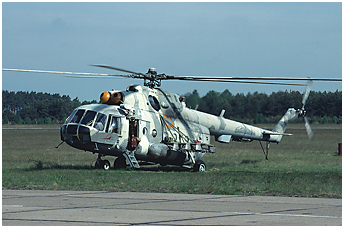 In the second week of August the helicopters of the 487.OVP BU left Werrneuchen in two groups for a long journey to their
present base at Budyonnovsk in the Caucasus (just like the Su-25 “Frogfoot” of the former 368.OShAP from Demnin Tütow).
The regiment is now reduced to one combat helicopter squadron and one transport helicopter squadron that were absorbed by the
6971st Air Base, still based at Budyonnovsk.
In 1994 only three helicoper bases of the Army Aviation and the VVS (1)
were still active in the former DDR: Mahlwinkel, Sperenberg and Oranienburg. The first machines
to depart this year were the Mi-6, Mi-8 and Mi-24 helicopters of the 113.OSAE at Sperenberg. Between April and June small groups
left their Brandenburg base for Russia. One of the group’s final destination was Kaluga, about 200 kilometers south of Moscow.
On Friday 13 May, 19 helicopters of the 337.OBVP at Mahlwinkel started their 7000 kilometers long journey, which would last
10 days. Their final destination was the base of Berdsk, near Novossibirsk in Siberia. On 16 and 24 Mai the last 38 helicopters
of the regiment left Germany.
In the second week of August the helicopters of the 487.OVP BU left Werrneuchen in two groups for a long journey to their
present base at Budyonnovsk in the Caucasus (just like the Su-25 “Frogfoot” of the former 368.OShAP from Demnin Tütow).
The regiment is now reduced to one combat helicopter squadron and one transport helicopter squadron that were absorbed by the
6971st Air Base, still based at Budyonnovsk.
In 1994 only three helicoper bases of the Army Aviation and the VVS (1)
were still active in the former DDR: Mahlwinkel, Sperenberg and Oranienburg. The first machines
to depart this year were the Mi-6, Mi-8 and Mi-24 helicopters of the 113.OSAE at Sperenberg. Between April and June small groups
left their Brandenburg base for Russia. One of the group’s final destination was Kaluga, about 200 kilometers south of Moscow.
On Friday 13 May, 19 helicopters of the 337.OBVP at Mahlwinkel started their 7000 kilometers long journey, which would last
10 days. Their final destination was the base of Berdsk, near Novossibirsk in Siberia. On 16 and 24 Mai the last 38 helicopters
of the regiment left Germany.
 Unfortunately on 16 Mai shortly after a planned landing at Oranienburg, the Mi-24V “Hind-E” (bort
number 36 yellow) became victim of a technical problem (the press mentioned a physical problem with the pilot) and crashed at
Fichtengrund, about 2 kilometers from the city of Oranienburg. The helicopter immediately caught fire and the
flying engineer was seriously hurt. Luckily the pilot and the WSO were only lightly wounded. The 337.OBVP became a combat and control regiment
(OVP BU) in 1997. The unit took part in operations in Chechnia from January 2000 on and flew missions in Africa under the UNO
control. The reduced regiment became part of the 6978th Air Base in October 2009: one Mi-24 squadron is remaining at Berdsk,
whereas a Mi-8 squadron is based at Tolmachevo.
In May 1994, the swansong was nearby and the last base remaining to evacuate was Oranienburg. The last ZGV helicopters were going to leave their base,
of which the runway would, some year later, become a portion of the extended B96 road, rejoining the Berliner ring!
On 1st and 4th June the two squadrons of Mi-6A “Hook” of the 239 OGVP left for Kalinov in the Ukraine, followed by 30 Mi-8
“Hip” of the regiment. They flew to their new destination Yefremov in the Tula region just above Orel.
The final honors of turning a page in the history of the Twentieth Century went to a Mi-8 of the unit, which had its departure
delayed due to a technical problem. It became the last aircraft of a combat unit of the former Soviet Army to leave the former
East German airspace.
Unfortunately on 16 Mai shortly after a planned landing at Oranienburg, the Mi-24V “Hind-E” (bort
number 36 yellow) became victim of a technical problem (the press mentioned a physical problem with the pilot) and crashed at
Fichtengrund, about 2 kilometers from the city of Oranienburg. The helicopter immediately caught fire and the
flying engineer was seriously hurt. Luckily the pilot and the WSO were only lightly wounded. The 337.OBVP became a combat and control regiment
(OVP BU) in 1997. The unit took part in operations in Chechnia from January 2000 on and flew missions in Africa under the UNO
control. The reduced regiment became part of the 6978th Air Base in October 2009: one Mi-24 squadron is remaining at Berdsk,
whereas a Mi-8 squadron is based at Tolmachevo.
In May 1994, the swansong was nearby and the last base remaining to evacuate was Oranienburg. The last ZGV helicopters were going to leave their base,
of which the runway would, some year later, become a portion of the extended B96 road, rejoining the Berliner ring!
On 1st and 4th June the two squadrons of Mi-6A “Hook” of the 239 OGVP left for Kalinov in the Ukraine, followed by 30 Mi-8
“Hip” of the regiment. They flew to their new destination Yefremov in the Tula region just above Orel.
The final honors of turning a page in the history of the Twentieth Century went to a Mi-8 of the unit, which had its departure
delayed due to a technical problem. It became the last aircraft of a combat unit of the former Soviet Army to leave the former
East German airspace.
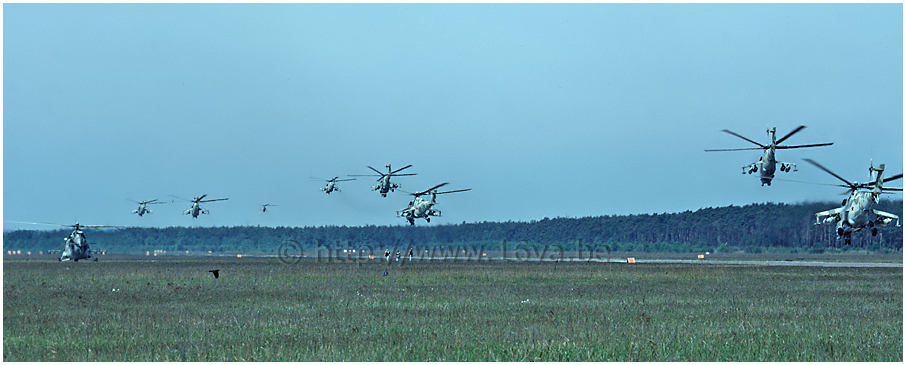 Proshchay Mahlwinkel! (16/05/94). © H.Mambour
Proshchay Mahlwinkel! (16/05/94). © H.Mambour
notes
(1)
The 113.OVE BU, 239.OGVP and 292.OVE REB were subordinated to the 16.VA HQ. These units always remained subordinated to VVS
structures.
 |
Plan du site - Sitemap |  |
